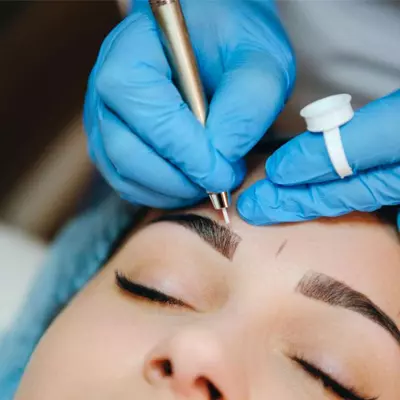With so many products and services available, we get a ton of options to have lush and thick eyebrows. However, one treatment has taken the cosmetic world by storm; it’s called microblading. Microblading involves implanting pigment into the skin using a handheld tool with fine needles. By the first impression of this cosmetic treatment, you may ask yourself, “Is microblading a tattoo?”
This blog post is intended to answer this question. But first, let’s have a brief overview of microblading itself.
What is Microblading?
Microblading is a technique that uses a handheld tool with fine needles to implant pigment into the skin, creating the illusion of fuller eyebrows. It is not considered traditional tattooing. So whether you want the appearance of natural light finish or bolder brows, you can get your desired appearance with this treatment.
First off, the skin doctor determines the brow shape and color based on the skin tone and patient’s preferences. Then, they use a microblade tool to inject color pigments into the treatment area to create the look of natural hairs.
Since the injected color pigments can fade with time, you may need to get touch-up sessions to keep your desired brow look for a longer term.
While this procedure is known to create the look of natural and more defined eyebrows, it is not without drawbacks. While multiple follow-up sessions may be needed to achieve the desired results, the timing can vary depending on individual healing and the practitioner’s recommendation. Generally, touch-up sessions are scheduled 4-8 weeks after the initial treatment. And the number of sessions will depend on your skin type and lifestyle factors.
Even after the treatment is complete, its results will not last forever. Generally, you get the looks of fuller brows for up to three years, after which the pigment starts fading.
Is Microblading a Tattoo?
Now, let’s answer the central question of this blog post. Because microblading is often referred to as ‘cosmetic tattooing’ or ‘microblading tattoo,’ many people confuse this procedure with eyebrow tattooing. However, both these cosmetic techniques are not the same. How? You will find it out in the following lines.
Microblading involves hand-drawn lines, while eyebrow tattooing uses a device.
The method used in either procedure significantly impacts what entails after the treatment. The microblading tool features a blade or needles that help create fine, hair-like strokes. Unlike traditional tattoos, the pigment does not spread or bleed over time.
On the other hand, eyebrow tattooing involves using a machine that punctures the skin numerous times while injecting the pigment. This way of injecting ink cannot create fine lines and may cause the injected ink to spread, leading to a thickened tattoo appearance after a few years.
The retentiveness of microblading is different from that of an eyebrow tattoo.
Since microblading involves implanting pigment into the skin, the fine lines created may start fading after 1-3 years. This ink can move around in the dermis to become less prominent over time and eventually disappears.
Conversely, eyebrow tattooing involves implanting ink into the skin using a machine. Hence, the results of this form of tattooing remain remarkably consistent.
Microblading inks do not lose their hue.
While the overall lifespan of microblading results is shorter than that of traditional tattooing, the pigments used in this treatment retain their color. On the contrary, the conventional tattoo doesn’t offer this perk as its dark color may turn blue or brown over time.
Microblading is less painful compared to eyebrow tattooing.
Another significant difference between microblading and tattoos is that the latter uses fast-acting needles to inject the pigment into the skin. The numerous punctures created as a result may cause significant pain in the tattooed area. Microblading, on the other hand, doesn’t involve needle penetration beyond the top portion of the dermal layer. Moreover, this treatment uses thinner needles. For these reasons, Microblading is generally considered less painful than traditional tattooing techniques, but the level of pain experienced can vary from person to person. Pain tolerance and the use of numbing agents during the procedure can also influence the level of discomfort.
Microblading offers more natural results compared to traditional eyebrow tattooing.
As discussed above, Every fine line created during microblading is made by implanting pigment with a handheld tool. These lines blend in with other hair strands and create a natural, fuller eyebrow look. Conversely, Eyebrow tattoos can have a more artificial appearance that may be easily distinguishable.
There is another type of tattooing called Microshading, which is also slightly different from microblading.
Eyebrow Tattoos vs. Microblading – What’s the Catch?
When discussing tattooing options for eyebrows, microblading is often considered a preferred choice due to the relatively lower pain involved in the procedure and the potential for more natural-looking results. However, the choice of the practitioner administering this treatment plays a vital role. You have to make sure that you get this treatment from an experienced and skilled practitioner.


